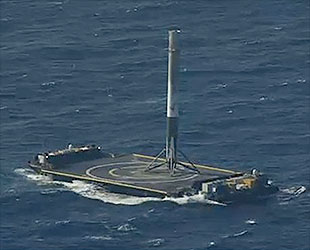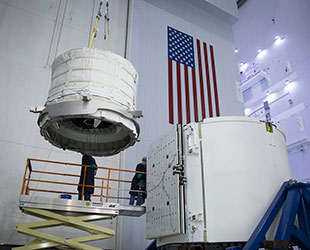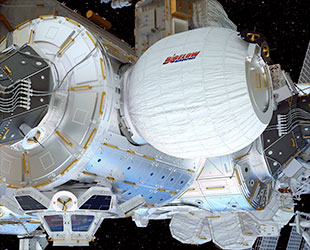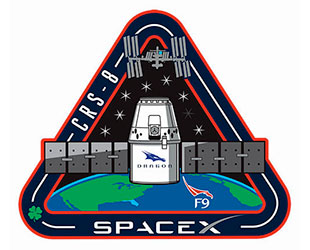April 8, 2016 – A prototype inflatable space habitat is now on its way to the International Space Station, flying aboard the first SpaceX Dragon cargo spacecraft to launch since a failure last summer.
Riding atop a SpaceX Falcon 9 rocket, the Dragon capsule with Bigelow Aerospace's BEAM – or Bigelow Expandable Activity Module – lifted off from Cape Canaveral Air Force Station, Florida at 4:43 p.m. EDT (2043 GMT) Friday (April 8).
The launch marked a return to flight for Dragon, following the loss of SpaceX's previous uncrewed cargo freighter in an in-flight breakup of a Falcon 9 rocket in June 2015. The result of faulty struts in the rocket's second stage, SpaceX corrected the problem and has since had three successful launches, including two commercial satellites and a NASA-led international Earth observation satellite, prior to Dragon taking flight on Friday afternoon.
Set to arrive at the orbiting laboratory on Sunday morning, Dragon's rendezvous and berthing will be the first time that two U.S. commercial cargo vehicles have been attached to the space station simultaneously. Orbital ATK's "S.S. Rick Husband" Cygnus cargo freighter arrived at the outpost on March 26.
With the addition of Dragon, the station will be supporting six berthed and docked craft, including two Soyuz and two Progress Russian capsules. The record number of visiting vehicles has been matched only one time before, when the space shuttle Discovery docked to the space station during its final mission, STS-133, in 2011.

SpaceX's Falcon 9 first stage is seen after successfully landing on the autonomous spaceport drone ship in the ocean. (SpaceX) |
Friday's launch also recorded one other first with SpaceX finally succeeding in landing the Falcon's first stage on an ocean-based platform. The company's prior attempts to fly the booster to a touchdown on the autonomous spaceport drone ship ended in the vehicle missing the floating pad or hitting it too hard and exploding.
This time, the stage stuck the landing, bringing SpaceX a step closer to its plans for reusing the rockets, which CEO Elon Musk has said will lower launch costs. Prior to Friday, the company had only been able to recover a first stage by landing it on a pad at the Cape.
Space to expand
Launched in the Dragon's unpressurized trunk, the BEAM will be extracted from the spacecraft and mounted to the space station's Harmony node using the orbiting complex's robotic arm. BEAM will then remain in its unexpanded form until late May, when it will be inflated to a size four times its launch volume, or about the size of a small bedroom.

The Bigelow Expandable Activity Module (BEAM) being loaded into the trunk section of SpaceX's Dragon spacecraft. (SpaceX) |
"We use [the space station's] air to inflate BEAM to its full shape," said Rajib Dasgupta, NASA's project manager for the module. "Once that is done, the crew releases the air from the eight inflation tanks from [inside] BEAM and that air pressurizes the module."
Constructed of multiple layers of a proprietary, Vectran-like soft material, once expanded and pressurized the BEAM is designed to be as tough as the more traditional solid body modules that form the space station's other rooms. But as the module is considered to be an experiment and not an addition to the complex's living space, crew members are expected to enter the BEAM only three to four times a year for just a few hours at a time to take measurements and monitor its performance to help inform the design of future expandable habitats.
"We are in the early phase of a new kind of spacecraft that offers a lot of promise," said Robert Bigelow, the president of Bigelow Aerospace and owner of the Budget Suites of America hotel chain. "We are anxious for this project to be launched and for it to be successful, and then we can start working on the next iteration of the next spacecraft."

Artist's rendering of the BEAM inflatable module fully expanded on the International Space Station. (Bigelow Aerospace) |
Barring any problems, BEAM will remain connected to the station for two years and then will be jettisoned to fall back into the Earth's atmosphere to be destroyed.
Mice, cabbage and more
In addition to BEAM, SpaceX's Dragon is also delivering to the space station about 3,800 pounds (1,700 kg) of crew supplies, spacewalk equipment and science investigations.
Riding inside the pressurized capsule are 20 mice that will be the subject of a skeletal muscle atrophy and weakness study sponsored by the pharmaceutical company Eli Lilly. Spaceflight is known to cause bone and muscle mass loss, with symptoms similar to those experienced by people with muscle wasting diseases or with limited mobility on Earth. The experiment will test an antibody that has been known to prevent muscle degradation in mice on Earth.

SpaceX Commercial Resupply Services-8 (CRS-8) patch. (SpaceX) |
Also on the Dragon are "Tokyo Bekana" Chinese cabbage and "Outredgeous" red romaine lettuce seeds to be grown in the station's Veggie facility. The plants, selected for how well they grow and taste, as well as their nutritional value, will be the second crop of vegetables to be cultivated and consumed by the station's astronauts, should they grow as expected.
Other research arriving on Dragon include a study of fluids at the nanoscale, or atomic, level; a study of the microbial flora on the station over time; a study of fungi to potentially support developing new medicine; and a student-designed experiment to test if a means of copying small segments of DNA could be used to study the alterations that astronauts undergo during flight.
The CRS-8 Dragon, SpaceX's eighth of up to 20 that the company is contracted to fly for NASA, will stay connected to the space station through May 11.
Repacked with science results, including the biological and medical samples collected by Scott Kelly during his nearly one-year expedition on the station, the capsule will return to Earth under parachutes and splash down in the Pacific Ocean off the coast of California for its recovery.
